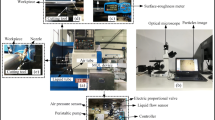Abstract
In this study, a method is developed to determine the oil mist characteristics for the minimal quantity lubricant process. The oil mist is characterized by the size, velocity, and volume flow rate of its particles. In each case, a specific measurement process is used: the laser diffraction granulometry method, the particle image velocimetry, and the gravimetric method. These methods are used in the case of static and simple models with different inner channels. Experimental tests have been done with the same inner channel as the existing spindle inner channel. Different output models with different inner canalizations have been tested, using these experimental processes. The main goal is to control the characteristics of output oil mist as a function of the input oil mist device parameters.
Similar content being viewed by others
References
Klocke F, Eisenblatter G (1997) Dry cutting. Ann ClRP 46:519–526
Heinemann R, Hinduja S, Barrow G, Petuelli G (2006) Effect of MQL on the tool life of small twist drills in deep-hole drilling. Int J Mach Tool Manuf 46(1):1–6
Tasdelen B (2008) Analysis and application of minimum quantity lubrication (MQL). thesis, Chalmers University of Technology
Lopez de Lacalle LN, Angulo C, Lamikiz A, Sanchez JA (2006) Experimental and numerical investigation on the effect of spray cutting fluids in high speed milling. J Mater Process Technol 172:11–15
Dhar NR, Ahmed MT, Islam S (2006) An experimental investigation on the effect of minimum quantity lubrication in machining AISI 1040 steel. Int J Mach Tool Manuf 47:748–753
Machado AR, Wallbank J (1997) The effect of extremely low lubricant volumes in machining. Wear 210:76–82
Aoyama T (2002) Development of a mixture supply for machining with minimal quantity lubrication. CIRP Ann Manuf Technol 51(1):289–292
Rahman M, Senthil Kumar A, Salam MU (2002) Experimental evaluation on the effect of minimal quantities of lubricant in milling. Int J Mach Tool Manuf 42:539–547
Obikawa T, Kamata Y, Shinozuka J (2006) High speed grooving applying MQL. Int J Mach Tool Manuf 46:1854–1861
Kamata Y, Obikawa T (2007) High speed MQL finish turning of Inconel 718 with different coated tools. J Mater Process Technol 192:281–286
Obikawa T, Kamata Y, Asano Y, Nakayama K, Otieno AW (2008) Micro-liter lubrication machining of Inconel 718. Int J Mach Tools Manuf 48(15):1599–1604
Aoyama T, Kakunima Y, Yamashita M, Aoki M (2008) Development of a new lean lubrication system for near dry machining process. CIRP Ann Manuf Technol 57:125–128
Attanasio A, Gelfi M, Giardini C, Remino C (2006) Minimal quantity lubrication in turning: effect on tool wear. Wear 260:333–338
Park K-H, Olortegui-Yume J, Yoon M-C, Kwon P (2010) A study on droplets and their distribution for minimum quantity lubrication (MQL). Int J Mach Tool Manuf 50:824–833
Benajes J, Molina S, González C, Donde R (2008) The role of nozzle convergence in diesel combustion. Fuel 87:1849–1858
Peiner E, Balke M, Doering L (2009) Form measurement inside fuel injector nozzle spray holes. Microelectron Eng 86:984–986
Kelly JF, Cotterell MG (2002) Minimal lubrication of aluminium alloys. J Mater Process Technol 120:327–334
Wakabayashi T, Suda S, Inasaki I, Terasaka K, Musha Y, Toda Y (2007) Tribological action and cutting performance of MQL media in machining of aluminum. Manuf Technol 56(1):97–100
Suda S, Wakabayashi T, Inasaki I, Yokota H (2004) Multifunctional application of a synthetic ester to machine tool lubrication based on MQL machining lubricants. CIRP Ann Manuf Technol 53(1):61–64
Feret L, Lacour C, de Chasemartin S, Ducruix S, Durox D, Laurent F, Massot M (2009) Pulsated free jets with polydisperse spray injection: experiments and numerical simulations. Proc Combust Inst 32(2):2215–2222
Priol L, Baudel P, Louste C, Romat H (2005) Laser granulometry measurements on electrified jets for different lengths of injector. J Electrost 63:899–904
Mitchell JP, Nagel MW, Nichols S, Nerbrink O (2006) Laser diffractometry as a technique for the rapid assessment of aerosol particle size from inhalers. J Aerosol Med 19(4):409–433
KWONG WTJ, HO SL, COATES AL (2000) Comparison of nebulized particle size distribution with Malvern laser diffraction analyzer versus Andersen cascade impactor and low-flow Marple personal cascade impactor. J Aerosol Med 13(4):303–314
Vecellio None L, Grimbert D, Becquemin MH, Boissinot E, Le Pape A, Lemarié E, Diot P (2001) Validation of laser diffraction method as a substitute for cascade impaction in the European project for a nebulizer standard. J Aerosol Med 14(1):107–114
Husted BP, Petersson P, Lund I, Holmstedt G (2009) Comparison of PIV and PDA droplet velocity measurement techniques on two high-pressure water mist nozzles. Fire saf J 44:1030–1045
Schliter T, Merzkirch W (1996) PIV measurements of the time-averaged flow velocity downstream of flow conditioners in a pipeline. Flow Meas Instrum 7:173–179
Ozalp C, Pinarbasi A, Fakilar MS, Sahin B (2007) PIV measurements of flow through a sudden contraction. Flow Meas Instrum 18:121–128
Vecellio L, Grimbert D, Bordenave J, Benoit G, Furet Y, Fauroux B, Boissinot E, De Monte M, Lemarié E, Diot P (2004) Residual gravimetric method to measure nebulizer output. J Aerosol Med 17(1):63–71
Tandon R, McPeck M, Smaldone GC (1997) Measuring nebulizer output: aerosol production vs gravimetric analysis. Chest 111(5):1361–1365
Adiga KC, Willauer HD, Ananth R, Williams FW (2009) Implications of droplet breakup and formation of ultra fine mist in blast mitigation. Fire Saf J 44:363–369
Author information
Authors and Affiliations
Corresponding author
Rights and permissions
About this article
Cite this article
Duchosal, A., Leroy, R., Vecellio, L. et al. An experimental investigation on oil mist characterization used in MQL milling process. Int J Adv Manuf Technol 66, 1003–1014 (2013). https://doi.org/10.1007/s00170-012-4384-9
Received:
Accepted:
Published:
Issue Date:
DOI: https://doi.org/10.1007/s00170-012-4384-9



